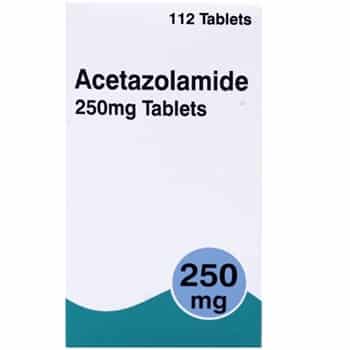North American guidelines recommend an Acetazolamide for Altitude Sickness dose of 125 mg orally twice daily, 1 to 2 days prior to climbing. Continue taking it while climbing and for at least 48 hours after.
- Diamox tablets are 250mg, so you can take 1/2 tablet (125mg) twice daily.
- You can also try a lower dose of acetazolamide (62.5 mg twice daily).
Acetazolamide is a medication used to treat altitude sickness. Some studies have tried to determine what is the minimum dosage that can be used, while still retaining its benefits. Generally a lower dosage is preferred in order to prevent side any potential side effects, but going too low of a dosage may not give its full benefits.
In the video below, Dr. Donner discusses the use of Acetazolamide (sold under the trade name Diamox) in the prevention and treatment of acute mountain sickness (AMS).
Studies about Acetazolamide for altitude sickness dose

In order to determine the lowest effective dose of acetazolamide for the treatment of acute mountain sickness, 11 scientific studies were performed. The efficacy of three different dosages were tested:
- 250 mg
- 500 mg
- 750 mg
All 3 doses of Acetazolamide were shown to be effective in preventing acute mountain sickness above 3000 m in the subjects participating on this study. However, the lowest dosage found to be the effective was 250 mg daily. This 250 mg daily dose was split in two 125 mg doses per day in a different study, without affecting it’s effectiveness:
Study 1
- Title: Efficacy of low-dose acetazolamide (125 mg BID) for the prophylaxis of acute mountain sickness: a prospective, double-blind, randomized, placebo-controlled trial.
Subject Information
- Number of Subjects: 155.
- Health status: healthy male and female trekkers of diverse background.
Method Used
The objective of this study was to determine the efficacy of low-dose acetazolamide (125 mg twice daily) for the prevention of acute mountain sickness (AMS).
Mt. Everest region of Nepal between Pheriche (4243 m), the study enrollment site, and Lobuje (4937 m), the study endpoint.
Results
In the treatment group there was a statistically significant reduction in incidence of AMS (placebo group, 24.7%, 20 out of 81 subjects; acetazolamide group, 12.2%, 9 out of 74 subjects).
Treatment with acetazolamide resulted in a 50.6% relative risk reduction.
Of those with AMS, 30% in the placebo group (6 of 20) versus 0% in the acetazolamide group (0 of 9) experienced a more severe degree of AMS.
Secondary outcome measures favoring the treatment group included decrease in headache and a greater increase in final oxygen saturation at Lobuje.
Conclusions
We concluded that acetazolamide 125 mg twice daily was effective in decreasing the incidence of AMS in this Himalayan trekking population.
Furthermore, a different study was performed to test if the efficacy of low-dose acetazolamide 125 mg twice per day (250 mg), as currently used in the Himalayas, is significantly different from 375 mg twice per day (750 mg) of acetazolamide in the prevention of AMS, given that 750 mg may be excessive and is controversial.
Study 2
- Title: Acetazolamide 125 mg BD is not significantly different from 375 mg BD in the prevention of acute mountain sickness: the prophylactic acetazolamide dosage comparison for efficacy (PACE) trial.
Subject Information
- Number of Subjects: 82.
- Health status: healthy male and female trekkers of diverse background.
Method Used
The participants of this study were sampled from a diverse population of (non-Nepali) trekkers at Namche Bazaar (3440 m) in Nepal on the Everest trekking route as they ascended to study midpoints (4280 m/4358 m) and the endpoint, Lobuje (4928 m), where data were collected.
Participants were randomly assigned to receive 375 mg twice per day of acetazolamide, 125 mg twice per day of acetazolamide (74 participants), or a placebo (66 participants), beginning at 3440 m for up to 6 days as they ascended to 4928 m.
Results
The results revealed that composite AMS incidence for 125 mg twice per day was similar to the incidence for 375 mg twice per day (24% vs. 21%), in contrast to significantly greater AMS (51%) observed in the placebo group. Both doses of acetazolamide improved oxygenation equally (82.9% for 250 mg daily and 82.8% for 750 mg daily), while placebo endpoint oxygen saturation was significantly less at 80.7%. There was also more paresthesia (tingling sensation) in the 375-mg twice per day group.
Conclusions
We conclude that 125 mg twice per day of acetazolamide is not significantly different from 375 mg twice per day in the prevention of AMS; 125 mg twice per day should be considered the preferred dosage when indicated for persons ascending to altitudes above 2500 m.
Study 3
- Title: Acetazolamide for the prevention of acute mountain sickness–a systematic review and meta-analysis.
Results
Acetazolamide was associated with a 48% relative-risk reduction compared to placebo.
There was no evidence of an association between efficacy and dose of acetazolamide.
Adverse effects were often not reported, but appeared to be common and generally mild.
One study found that side effects of acetazolamide were dose related.
Conclusions
Acetazolamide is effective for the prevention of symptoms of AMS in those going to high altitude.
A dose of 250 mg/day has similar efficacy to higher doses and may have less side-effects.
Acetazolamide side effects long term study
Acetazolamide side effects long-term might include:
- Paresthesias (tingling sensation)
- Hearing loss or tinnitus
- Anorexia
- Altered taste
- Nausea, vomiting
- Diarrhea
- Increased urination (polyuria)
- Fatigue, tiredness, drowsiness
- Confusion
- Increased body hair
Adverse effects were often not frequently reported but appeared to be common but generally mild. One study found that adverse effects of acetazolamide were dose related. A dose of 250 mg/day has similar efficacy to higher doses and may have a favorable side-effect profile.
Introduction: Acetazolamide (AZM) is used for various conditions (eg, altitude sickness, sleep apnoea, glaucoma), but therapy is often limited by its side effect profile. Our objective was to estimate the risk of commonly reported side effects based on meta-analyses. We hypothesised that these risks are dose-dependent.
Results: We included 42 studies in the analysis. Side effects included:
- Paraesthesia (tingling sensation)
- Dysgeusia (taste loss)
- Polyuria (frequent urination)
- Fatigue
The risk for paraesthesias and dysgeusia increased with higher AZM doses; the risk of fatigue also increased with higher dose but non-significantly.
Discussion: This comprehensive meta-analysis of low-to-moderate quality evidence defines risk of common AZM side effects and corroborates dose dependence of some side effects. These results may inform clinical decision making and support efforts to establish the lowest effective dose of AZM for various conditions.
Want To Know More?
Click the links below to access the individual topic pages:
Sources
This article makes use of information from the U.S. National Library of Medicine under the terms of the Creative Commons Attribution 4.0 International License.
- Ritchie ND, Baggott AV, Andrew Todd WT. Acetazolamide for the prevention of acute mountain sickness–a systematic review and meta-analysis. J Travel Med. 2012 Sep-Oct;19(5):298-307. doi: 10.1111/j.1708-8305.2012.00629.x. Epub 2012 Jul 30. PMID: 22943270.
- Basnyat B, Gertsch JH, Holck PS, Johnson EW, Luks AM, Donham BP, Fleischman RJ, Gowder DW, Hawksworth JS, Jensen BT, Kleiman RJ, Loveridge AH, Lundeen EB, Newman SL, Noboa JA, Miegs DP, O’Beirne KA, Philpot KB, Schultz MN, Valente MC, Wiebers MR, Swenson ER. Acetazolamide 125 mg BD is not significantly different from 375 mg BD in the prevention of acute mountain sickness: the prophylactic acetazolamide dosage comparison for efficacy (PACE) trial. High Alt Med Biol. 2006 Spring;7(1):17-27. doi: 10.1089/ham.2006.7.17. PMID: 16544963.
- Basnyat B, Gertsch JH, Johnson EW, Castro-Marin F, Inoue Y, Yeh C. Efficacy of low-dose acetazolamide (125 mg BID) for the prophylaxis of acute mountain sickness: a prospective, double-blind, randomized, placebo-controlled trial. High Alt Med Biol. 2003 Spring;4(1):45-52. doi: 10.1089/152702903321488979. PMID: 12713711.
- Low EV, Avery AJ, Gupta V, Schedlbauer A, Grocott MP. Identifying the lowest effective dose of acetazolamide for the prophylaxis of acute mountain sickness: systematic review and meta-analysis. BMJ. 2012 Oct 18;345:e6779. doi: 10.1136/bmj.e6779. PMID: 23081689; PMCID: PMC3475644.
- Sridharan K, Sivaramakrishnan G. Pharmacological interventions for preventing acute mountain sickness: a network meta-analysis and trial sequential analysis of randomized clinical trials. Ann Med. 2018;50(2):147-155. doi:10.1080/07853890.2017.1407034
- Schmickl CN, Owens RL, Orr JE, Edwards BA, Malhotra A. Side effects of acetazolamide: a systematic review and meta-analysis assessing overall risk and dose dependence. BMJ Open Respir Res. 2020 Apr;7(1):e000557. doi:

